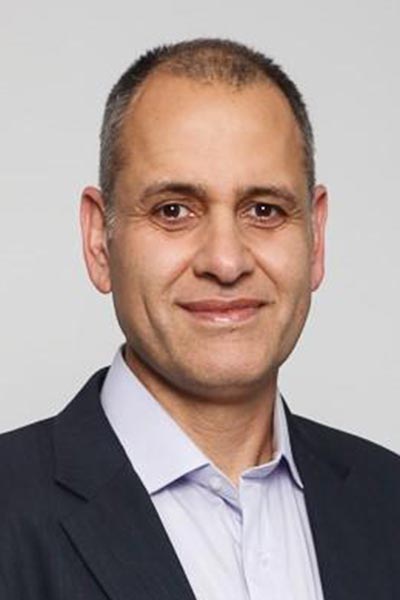We are entering a new era that will dramatically transform humanity as we know it. The introduction of artificial intelligence (AI) and quantum computing is inspiring a revolution that could be more radical and far-reaching than the industrial revolution. There is no going back; the power of these technologies is growing exponentially and will affect every aspect of our lives, including healthcare.

While precision oncology has brought about a paradigm shift in lung cancer treatment by tailoring therapies to each patient, the real tectonic shift will come with the integration of these novel AI technologies and their power of prediction. Imagine being able to precisely calculate medical outcomes using a patient’s “big data,” including all the variables of their medical history, medical images, genomics, proteomics, and even patient preferences. That data coupled with the immense power of AI modeling based on previous patients could help us predict the best possible course of treatment as well as the best treatment sequence while considering likely mechanisms of acquired resistance, optimizing dosing, and predicting side effects. And it could all be done in mere seconds, non-invasively.1
Indeed, this AI revolution could allow the field of preventive oncology to harness the rapidly growing power of AI and quantum computing to ultimately predict and treat cancer before it develops. Is such a scenario just a dream?
Of course, there will be challenges to overcome before such a dream can become a reality. However, the past decade of research has set the stage for incorporation of AI into clinical workflows to improve outcomes for lung cancer patients.2,3,4,5 AI-based tools have also been used to evaluate eligibility for clinical trials using real-world data;6 to improve the histopathological grading of lung adenocarcinoma;7 and to facilitate the multimodal integration of radiological, pathomic, transcriptomic, and genomic data to predict immunotherapy response in patients with non-small cell lung cancer.8

On this path to fully personalized oncology, one of the biggest obstacles is the time required from biomarker identification to drug development and subsequent clinical trials. The whole process can take 10 to 15 years and entails considerable financial investment. Fortunately, AI may also help us overcome this challenge. Systems already exist that incorporate the power of generative AI with robotics to shorten this process to as little as 18 months from discovery to phase I clinical trials.9
And while these valuable technologies are still being evaluated for use in clinical oncology workflows, efforts to remove roadblocks and develop accessible open-source AI toolkits and therapeutic frameworks for AI-based decision-making tools are currently underway.1 One notable example is the I3LUNG project, a European Commission research initiative that aims to develop a decision-making tool that will make AI-based multi-omics for individualized lung cancer care a reality.10
While these technologies undoubtedly pose a fair share of challenges, the final outcomes will depend on our ability and determination to establish the necessary policies and safeguards as we progress. We must adapt, accept, and embrace these invaluable and revolutionary technologies, without neglecting the need to evaluate them thoroughly and carefully.
References
- 1. Roisman LC, Kian W, Anoze A, et al. Radiological artificial intelligence – predicting personalized immunotherapy outcomes in lung cancer. npj Precision Oncology 2023 7:1. 2023;7(1):1-7. doi:10.1038/s41698-023-00473-x
- 2. Bera K, Braman N, Gupta A, Velcheti V, Madabhushi A. Predicting cancer outcomes with radiomics and artificial intelligence in radiology. Nat Rev Clin Oncol. 2022;19(2):132-146. doi:10.1038/s41571-021-00560-7
- 3. Lambin P, Rios-Velazquez E, Leijenaar R, et al. Radiomics: extracting more information from medical images using advanced feature analysis. Eur J of Cancer. 2012;48(4):441-446. doi:10.1016/j.ejca.2011.11.036
- 44. Aerts HJWL, Velazquez ER, Leijenaar RTH, et al. Decoding tumour phenotype by noninvasive imaging using a quantitative radiomics approach. Nat Commun. 2014;5. doi:10.1038/ncomms5006
- 5. Primakov SP, Ibrahim A, van Timmeren JE, et al. Automated detection and segmentation of non-small cell lung cancer computed tomography images. Nature Communications 2022 13:1. 2022;13(1):1-12. doi:10.1038/s41467-022-30841-3
- 6. Liu R, Rizzo S, Whipple S, et al. Evaluating eligibility criteria of oncology trials using real-world data and AI. Nature. 2021;592(7855):629-633. doi:10.1038/S41586-021-03430-5
- 7. Pan X, AbdulJabbar K, Coelho-Lima J, et al. The artificial intelligence-based model ANORAK improves histopathological grading of lung adenocarcinoma. Nat Cancer. 2024;5(2). doi:10.1038/S43018-023-00694-W
- 8. Vanguri RS, Luo J, Aukerman AT, et al. Multimodal integration of radiology, pathology and genomics for prediction of response to PD-(L)1 blockade in patients with non-small cell lung cancer. Nature Cancer 2022 3:10. 2022;3(10):1151-1164. doi:10.1038/s43018-022-00416-8
- 9. Ren F, Aliper A, Chen J, et al. A small-molecule TNIK inhibitor targets fibrosis in preclinical and clinical models. Nat Biotechnol. Published online 2024. doi:10.1038/S41587-024-02143-0
- 10. Prelaj A, Ganzinelli M, Trovo’ F, et al. The EU-funded I3LUNG Project: Integrative Science, Intelligent Data Platform for Individualized LUNG Cancer Care With Immunotherapy. Clin Lung Cancer. 2023;24(4):381-387. doi:10.1016/j.cllc.2023.02.005




